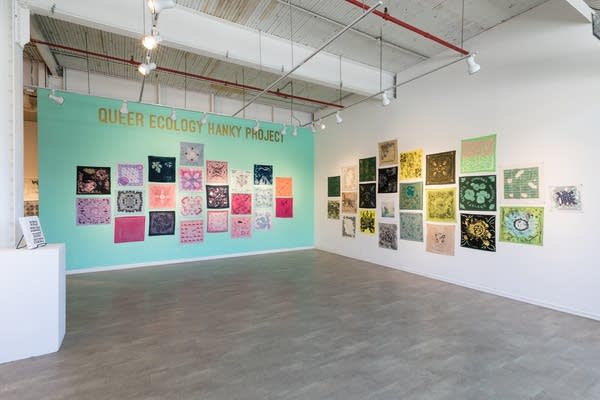Building off history: UMN symposium showcases queer culture through bandana art

Go Deeper.
Create an account or log in to save stories.
Like this?
Thanks for liking this story! We have added it to a list of your favorite stories.
Updated: 9:11 a.m.
My little ponies dance upon mushroom caps, pollinators hover over flowers and male salamanders fornicate in vernal pools — all these scenes play out in their own 22-inch square.
They are part of the Queer Ecology Hanky Project, an ongoing national touring exhibition that opens at the University of Minnesota March 23. It features more than 100 hand-printed bandanas.
The salamander hanky is by Corinne Teed, a local artist and assistant professor of art at the university who studies queer ecology. Queer ecology, Teed says, is the study of biology, the environment, and sexuality through the intersectional framework of queer theory.
Their hanky was inspired by an experience they had giving an artist talk at Bowdoin College in 2019. Teed recalls showing a video about how nature documentaries often omit the existence of queer relationships in various animal species.
Turn Up Your Support
MPR News helps you turn down the noise and build shared understanding. Turn up your support for this public resource and keep trusted journalism accessible to all.
A biologist who researches salamanders chimed in, saying that for decades, she had observed male salamanders having group sex in vernal pools; after, the female salamanders would come to the pools to lay eggs. The biologist told Teed that she had always framed this act as part of heterosexual reproduction.
“Never once had I considered that those salamanders were enjoying themselves, or that you might think of those relationships as queer,” Teed recalls the biologist saying. Teed wanted to honor these salamanders, and that bandana now hangs in the university’s Quarter Gallery at the Regis Center for Art.
The hanky exhibition is part of the Queer and Trans Ecologies Symposium at the University of Minnesota. Teed will be speaking about their art research at the three-day event, which runs March 23-25 and is free and open to the public.
It will also include sessions, panels, and workshops on queer food, fermentation, and intersectional environmental humanities.

Erin Durban, an assistant professor of anthropology, is the main organizer for the symposium. Durban explains the name of the symposium honors how queer and trans ecology are unique areas of study, as the transgender experience often differs from others in the community. They say the symposium is happening at a time of crisis.
“I have thought a lot about what it means to have the event right now,” Durban says. “We're in a period of really intense backlash, not so much against the entire queer community, but especially nonbinary and trans people in the United States.”
Durban hopes it will be a space to feel safe while connecting folks from many areas of expertise. That includes artists.
“Queer ecology is huge in the arts,” says Durban, explaining that is why they invited the Hanky Project. “Each hanky is created by a different artist, and so they have a different interpretation of what queer means in relationship to ecologies, but also, as a really just important part of queer culture.”
The founders of the Queer Ecology Hanky Project are artists V. Adams and Mary Tremonte, who traveled to Minnesota from their homes in New Orleans and Pittsburgh. The soft launch of the exhibition, they say, was actually in 2019 at the White Page Gallery in Minneapolis. It has been growing and touring since.
Adams explains that the bandana has an important history in the queer community that dates back to the 1970s.
“Gay men in the Bay Area started a practice called ‘flagging,’ where they would put different colored bandanas in their pockets,” Adams explains. The bandana color would signify what someone was seeking. “It was a way of communicating that was nearly invisible, or mostly invisible to the uninitiated, but gay men could safely communicate their desires out in the open world.”
Now they are using the medium to encourage all LGTBQ+ artists to flag their perspective.
“Over the years, it’s gotten picked up by a lot of other queer artists who are interested in revisiting and expanding that code,” Adams says, “to a diversity of bodies, identities and desires. That is the history of what we are building off of.”
Tremonte says they have been “citizen ecologists” for years.
“I had been printing on hankies, making bandanas of ecological themes, looking at animals both that are in a gay pantheon of symbolic animals to gay culture, like hares, otters, hawks and wolves, but also just animals that humans find affinity with, like raccoons and possums,” Tremonte said.

Teed says they wanted to join the project because, as a printmaker, they have long printed on ephemera like hankies and zines. And because Adams and Fremonte create a sort of utopian space of queer thought and celebration.
“They do that with these exhibitions,” Teed says. “It is beautiful to walk amongst those hankies.”
While the symposium ends March 25 with a dance party at Public Functionary, the art exhibition will be up through April 22.
Correction (March 23, 2023): A previous version of the story inaccurately described an artist's pronouns; the story has been corrected.



